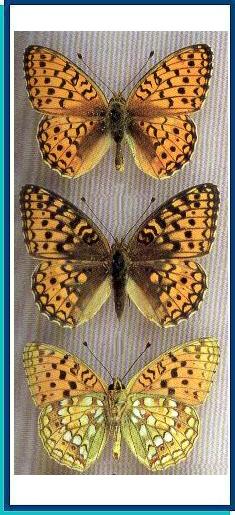LEPIDOPTERA
N Y M P H A L I D A E Swainson, 1827
ARGYNNIS Fabricius, 1807
Argynnis niobe (Linnaeus, 1758)
Argynnis niobe (Linnaeus, 1758)

• TYPE LOCALITY. «Europa».
• SYNONYMS. herse (Hufnagel, 1766); pelopia (Borkhausen, 1788); cleodoxa (Esper, [1789]).
• RANGE. From W. Europe to W. Siberia and from Turkey across Iran and Afghanistan to the Tian-Shan, the Altais and Transbaikalia.
• DISTRIBUTION AND VARIATION. Individual variability slighter than that among A. adippe, but this species has also two colour forms in males and females, i.e., with silvery spots on the UNH or without such spots (form eris Meigen, [1828]). Sexual dimorphism is poorly expressed- Geographical variability is somewhat stronger than that among the populations of A. adippe. Nearly all subspecies are rather clearly distinguishable from each other by the relative proportions of the colour forms. The nominotypical subspecies inhabits the Carpathian Mts., the central European part, and W. Siberia. The S. European part, the Caucasus and Transcaucasia are populated by the ssp. gigantea Staudinger, 1871 (= taura Rober, 1896; = orgowaTeich, 1901; = philistra Seitz, [1909]; = kuhlmanni Seitz, [1909]). The ssp. tekkensis Christoph, 1893 is known to occur in the Kopet-Dagh, while the ssp. ornata Staudinger, 1901 (= alaiensis Reuss, 1921) in the Ghissar-Darvaz and Pamirs-Alai. The ssp. orientalis Alpheraky, 1881 lives in the Tian-Shan, Tarbagatai and Saur mountains, while the ssp. changaica Reuss, 1922 in the Altai and Sayan mountains as well as Transbaikalia. The presence of this species in the Amur and Ussuri regions requires confirmation, yet the taxon voraxides Reuss, 1921 (TL: «Sotka Gora, Ussuri Gebiet») has been described from there. From the adjacent parts of Asia, the following six subspecies are known: intermedia Reuss, 1925 (TL: Beijing, China); valesinoides Reuss, 1926, from Korea; kurana Wyatt et Omoto, 1966 and shiua Wyatt et Omoto, 1966, both from Badahshan; demauendis Gross et Ebert, 1975 (TL: Elburs, Demavend, N. Iran); and khusestana Gross et Ebert, 1975 from Husestan, W. Iran.
• HABITATS AND BIOLOGY. As a whole, this species seems to be more thermophilic than A. adippe or A. aglqja, hence preferring drier places, e.g., steppe-like habitats up to 3,000 m a.s.l. Flight period: June to August. Host plant: Viola canina, V. trico-or, etc. Feeding nocturnal, therefore larvae difficult to detect. Hibernation as eggs or first larval instars. Pupation in grass inside a delicate cocoon.
• SIMILAR SPECIES. Argynnis nerippe, A. adippe, A. xipe: androconial scales on one, two or three veins of UPF present.
Photo and text: Guide to the BUTTERFLIES OF RUSSIA and adjacent territories Volume 2. PENSOFT, Sofia - Moscow. 2000